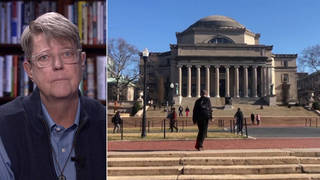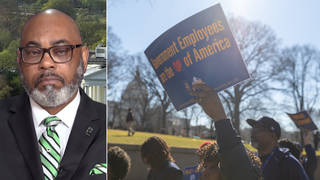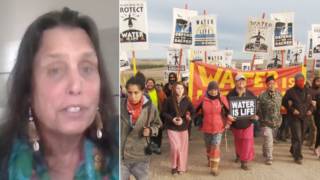
Guests
- Benjamin StraussCEO and chief scientist at Climate Central, co-author of a new study on rising sea levels published in the journal Nature Communications.
- Harjeet Singhthe global lead on climate change at ActionAid. He works with climate migrants in several countries and is based in New Delhi, India.
As a shocking new report finds that many coastal cities will be flooded by rising sea levels by 2050, Chile’s President Sebastián Piñera announced Wednesday that the U.N. climate summit in Santiago has been canceled. Anti-inequality protests have entered their third week in the country, with protesters calling for the Piñera government to resign. The U.N. said it is now looking for an alternative venue for the annual climate meetings. Meanwhile, a dire new report has warned 300 million people are at risk from rising sea levels, with the most vulnerable populations concentrated in the Global South. According to the study published in Nature Communications, global sea levels are expected to rise between two and seven feet, or possibly more, with some coastal cities being wiped off the map. We speak with Harjeet Singh, the global lead on climate change for ActionAid, who is based in New Delhi, India; and Benjamin Strauss, co-author of the study in Nature Communications and CEO and chief scientist at Climate Central.
Transcript
NERMEEN SHAIKH: As wildfires continue to rage in California and a shocking new report finds that many coastal cities will be permanently flooded by rising sea levels, Chile’s President Sebastián Piñera has canceled the upcoming U.N. climate summit. The two-week summit had been scheduled for December in the Chilean capital of Santiago, which has seen weeks of mass protests against the Chilean government’s neoliberal policies. The U.N. is now looking for an alternative venue. The annual climate meetings offer a critical space for developing countries to request greater help from rich nations as they confront the worst effects of the climate crisis.
Piñera’s announcement comes as a dire new report warns 300 million people are at risk of being displaced due to rising sea levels, three times more than previous estimates. According to the study published in Nature Communications, the vast majority of the most vulnerable populations are concentrated in Asia, with China, Bangladesh, India, Vietnam, Indonesia and Thailand facing the gravest threat.
AMY GOODMAN: The study finds global sea levels are expected to rise between two to seven feet, and possibly more, with some coastal cities being wiped off the map.
To talk more about the implications of the latest report, we’re joined by two guests. Here in New York, Benjamin Strauss is with us, CEO and chief scientist at Climate Central and co-author of the new study on rising sea levels. Harjeet Singh is the global lead on climate change at ActionAid, working with climate migrants in a number of countries, joining us from New Delhi, India.
We begin with Benjamin Strauss. Explain the report, the scope of the report and what you found.
BENJAMIN STRAUSS: Well, thanks so much for having me, Amy and Nermeen, to discuss such an important issue. We found that the global exposure to sea level rise and coastal flooding in the coming several decades is more than three times what we thought based on previous data. Essentially, almost all of climate science has been focused on the question of what the sea level will be in the future, which makes sense. That’s what’s changing: Sea level is rising. But you really need to know two things to understand the human vulnerability to sea level rise, and one is the height of the sea, but the other is the height of the land.
We all assumed that we knew that, that it was fixed and simple. But in my research with my colleague, Scott Kulp, we took a closer look at the data being used to estimate land elevations globally, and while there’s very accurate data in the United States and Australia and parts of Western Europe, the data set used for global analysis and most of Asia and the rest of the world overestimated coastal elevations by more than six feet, or two meters.
NERMEEN SHAIKH: Why did they do that? Why was there such a huge overestimation?
BENJAMIN STRAUSS: The data — the elevation was based on measurements taken from satellites. So, basically, the sensing beams that came down were very broad in their footprint, and so averaged in rooftops, buildings, treetops with the ground in determining the actual — in determining the elevation in the data set.
AMY GOODMAN: Let’s look at a map depicting southern Vietnam could all but disappear by 2050. In Shanghai, one of Asia’s most important economic engines, water threatens to consume the heart of the city and many other cities around it.
BENJAMIN STRAUSS: Yes. So, we’ve made an interactive map. We published a map together with the report so that any of your listeners can look really in any part of the world, if they go to Coastal.ClimateCentral.org. And we found huge changes in the major deltas of Asia compared to what we had previously thought.
Now, it is worth also noting that we discovered more than 100 million people today live on land that’s below the high tide line. And there’s a little piece of hope in that, which is, that means that most of them are likely to be protected by coastal defenses, to some degree. But, on the other hand, it also means that many people — we may not hear about it in the headlines — many people may already be suffering from frequent flooding and inundation affecting their lives and livelihoods.
AMY GOODMAN: And the new findings based on an innovative way to read satellites?
BENJAMIN STRAUSS: Yes. So what we did is we used artificial intelligence to try and improve on this elevation data from satellites. We took that satellite-based data set, but another 23 variables, and we fed it into a big algorithm soup, so to speak, in order to try and find an approach to improve those data. And we used about 50 million data points where we had a very accurate elevation reading, as well as the inaccurate satellite reading, to develop and calibrate the model. And then we used completely different sets of points in other areas to show that the model worked, even outside of the areas where we trained it. So that’s how we have confidence in these results.
NERMEEN SHAIKH: Well, I’d like to bring Harjeet Singh into the conversation. Harjeet Singh is with ActionAid, and he’s joining us from New Delhi, India. Harjeet, could you respond to the findings of this report, and, in particular, the fact that the vast majority of the most vulnerable areas, areas vulnerable to sea level rise, are in Asia?
HARJEET SINGH: Yeah. Thank you for having me here. Well, I am saddened but not surprised. We are already seeing such grim reality in different parts of the Global South. So, developing countries who had little role in causing the problem are already facing this climate emergency. Just to put it into context, 16 million people were displaced in 2018 by weather-related disasters, and now the estimates that are coming for sea level rise, if I talk of India, it’s seven times more the number, and in Bangladesh, it’s going to be eight times more than the previous estimate.
And people are being forced to leave their homes as their local coping mechanisms fail. Their farms and homes are being swallowed up by sea. I’ve met people who would point towards the sea several meters in from the shoreline to where their homes used to be and are now underwater. That’s the grim reality they are facing. They leave their families behind, particularly women, children and elderly. And we are seeing in this part of the world how families are getting disintegrated completely, and they have no place to go. And where they’ll end up, in urban areas and small towns and cities, they end up living in inhuman and unhygienic conditions. So that’s the reality which we are already facing, and with these numbers it becomes absolutely horrific.
NERMEEN SHAIKH: And, Harjeet, can you talk about what kind of support, if any, these climate migrants receive to help them move or resettle wherever they’re able to go?
HARJEET SINGH: Well, the reality is that developing countries are also not ready. We are now facing the climate emergency — or, what we call it, loss and damage, in the climate parlance. They have not even been ready with their adaptation plans. The whole concept of adaptation, which means preparing for these impacts, became much more active in 2001. And since then, they have not got any support from developed countries which is adequate for them to put these defenses that we are talking about, whether it’s about coastal protection, whether it’s about retrofitting homes or thinking of planned relocation, which is being talked about now at the U.N. level, but hardly any support has reached these communities. And we are talking of millions and millions of people in this part of the world.
AMY GOODMAN: Harjeet Singh, can you talk about this latest news that just broke yesterday as more than a million people were in the streets of Chile this past weekend? The embattled President Piñera announced that the U.N. climate summit would be canceled in December. It was going to be held in Santiago. Now the U.N. has to decide whether they have to put off this climate summit or whether they will find an alternative venue. But the significance of the cancellation at this point?
HARJEET SINGH: Well, let’s understand, the climate crisis and the social unrest in Chile or elsewhere have the same root cause. That’s inequality. Governments continue to prioritize corporations over the rights of people. And that’s why this uprising, this unrest that we are seeing in Chile. Now, with climate conference COP25 being canceled, it means — it’s a major jolt to the issue that we were supposed to be talking there. Loss and damage, the challenges that climate migrants are facing, was very much on the agenda. And it was all about how the institution that has been created in 2013 needs to be rebooted so that it can respond to the current reality and the future.
So, if I connect with what’s happening in Chile, what the COP was going to be discussing, and this new report, I think it’s really a terrible situation that we now will see this COP moving to some other city, and probably for 2020. Our hearts are with people of Chile. The fight that they are fighting is absolutely real. And as I said, the climate justice fight and the social unrest, they are all connected to the core cause of inequality, and we need to recognize that core cause behind these challenges.
NERMEEN SHAIKH: And, Harjeet, can you talk about that inequality also in the context of climate change, that countries that have historically emitted the least are now the most vulnerable?
HARJEET SINGH: Absolutely. So, if you look at historical emissions, the climate crisis that we are facing today is not a result of emissions that are happening now. The climate works on a lag system, so the emissions that have taken place in the last 150 years are causing the climate crisis that we face today. And if you look at these historical emissions, United States is responsible for more than quarter, and another quarter of emissions come from European Union. Now, that’s the inequality. Yes, China is the biggest polluter at the moment, but historical emissions come largely from United States and European Union.
And if you look at the emission reduction targets that they have put on the table, from the United States, European Union and even Japan, it’s one-fifth of their fair share. So, civil society organizations have come up with this calculator that looks at their historical responsibility, their GDP and their capability. And through that fault assessment, we have found that it’s only one-fifth.
And developing countries, on the contrary, have put their plans, which are far more ambitious and are — most of them are in line with keeping the temperature below 2 degrees Celsius. So, the inequality which has caused the problem also exists when it comes to climate action. And the business-as-usual approach that we see from majority of developed countries is not going to help. We need to be responding to the grave situation that we are facing at this moment.
AMY GOODMAN: I want to ask you about Indonesia announcing plans to relocate its capital. The capital city is Jakarta. It is going to relocate to the island of Borneo. Jakarta, which is home to over 30 million people, has been steadily sinking into the Java Sea. A study found over a quarter of Jakarta will be underwater within the next 10 years. Excessive extraction of groundwater, poorly managed environmental policies have led to Jakarta’s surface water becoming polluted and unfit for consumption. Rising sea levels from climate change further compound the issue. This is the Indonesian President Joko Widodo announcing the plans.
PRESIDENT JOKO WIDODO: [translated] The place has a minimum risk of natural disasters, such as floods, earthquakes, tsunami, forest fires, volcanoes and landslides. Secondly, the location is strategic, as it’s located in the center of Indonesia. And thirdly, it’s close to the other developed cities.
AMY GOODMAN: It’s not clear what will happen to the millions of Jakarta residents at risk of losing their homes and livelihoods as Jakarta is submerged in the coming years. But I want to ask each of you this question, starting with Harjeet Singh.
HARJEET SINGH: See, everything points to the unsustainable development model that we have created that continues to exploit nature, whether it’s about extraction of water at unsustainable levels and the man-made crisis called climate change that we have caused. I think we need to look at how we look at — how we treat development. What is our definition of development? And who is causing that destruction? Some of these fundamental questions, we need to ask.
The whole orientation towards GDP growth and completely ignoring what we are doing to environment has to change. Environment now has to be at the center of everything that we are doing. How we are using our natural resources, how we are building our homes, how we are using water, all that has to change. And that thinking is not yet there, despite some of these challenges that we are seeing. And look at the kind of actions we are now forced to take.
But our political leaders are still stuck with that thinking that corporations are going to solve the problem. And we are seeing privatization and not really rebooting the development model that we have created, which is responsible for all the crisis that we are facing in this world today.
AMY GOODMAN: And Ben Strauss?
BENJAMIN STRAUSS: Yes. Well, I think we have to look at Jakarta and really use it to understand we could all be Jakarta tomorrow. And, unfortunately, it’s a model for what could happen to many other coastal cities. Or we could look at New Orleans, which has more resources and has built a levy system to protect itself, but when a hurricane comes, we saw the tragedy that can take place when you live in the bottom of a bowl and the defenses fail. So, I think it’s a really, really important lesson that we have to take great heed of, that a major nation would go to the length of relocating their largest city and their capital city, or trying to do that.
NERMEEN SHAIKH: And very quickly, before we conclude, a city like Bombay, a population of almost 20 million, and the greater Bombay area, large parts of which will be underwater, according to this report, by 2050, that area includes where two nuclear installations are housed.
BENJAMIN STRAUSS: Oh, there’s a tremendous amount of infrastructure right by the coast everywhere, including nuclear facilities, hazardous waste sites of every kind. And, you know, if the ocean rises to submerge those areas, all kinds of nuclear waste or toxins and other noxious materials can be spread around. So we have an enormous cleanup or better defense effort in front of us. This is an entirely new problem in the course of human civilization. We really don’t have the institutions or the precedent to deal with the loss of land.
And I hope that with adequate warning, decades of warning, we have some chance of finding and investing resources to defend the places that we are able. But there’s a great inequity of resources around the world. It’s going to be very expensive. And some places, just by their geography, may be prohibitive to defend. So, yes, this really is a new chapter. And, you know, if I can find any silver lining in this — and it’s hardly one, but I’ll say that — just as the threat from sea level rise and coastal flooding turns out to be much greater than we thought it was —
AMY GOODMAN: Three times greater. Three hundred million people will be affected.
BENJAMIN STRAUSS: — three times greater — the benefits of cutting climate pollution would also be three times greater. Right? So, think of the benefit-cost equation that moves some audiences. It’s suddenly changed. But on the other hand, Harjeet made a very important point, is that there is a lag in the system. So, if I put a chunk of ice on the table in front of us right now — it’s very simple and profound — it wouldn’t melt instantly. It would take time. So, in the same way, the ice sheets on Antarctica and Greenland have just barely begun to respond to the warming that we have already caused.
AMY GOODMAN: We want to thank you so much for being with us, Benjamin Strauss, chief scientist at the news and science organization Climate Central, and Harjeet Singh, global lead on climate change at ActionAid, speaking to us from New Delhi, India.
When we come back, we continue on the climate crisis by looking at the fires still raging in California. The congressmember we’ll speak to is calling for PG&E to become a public utility. Then we’ll speak with a woman who is a former prisoner who fought fires while incarcerated. We’ll also talk about the housekeepers and the workers who are going to estates that are burning, where the owners have evacuated, but the people are not told. Stay with us.












Media Options